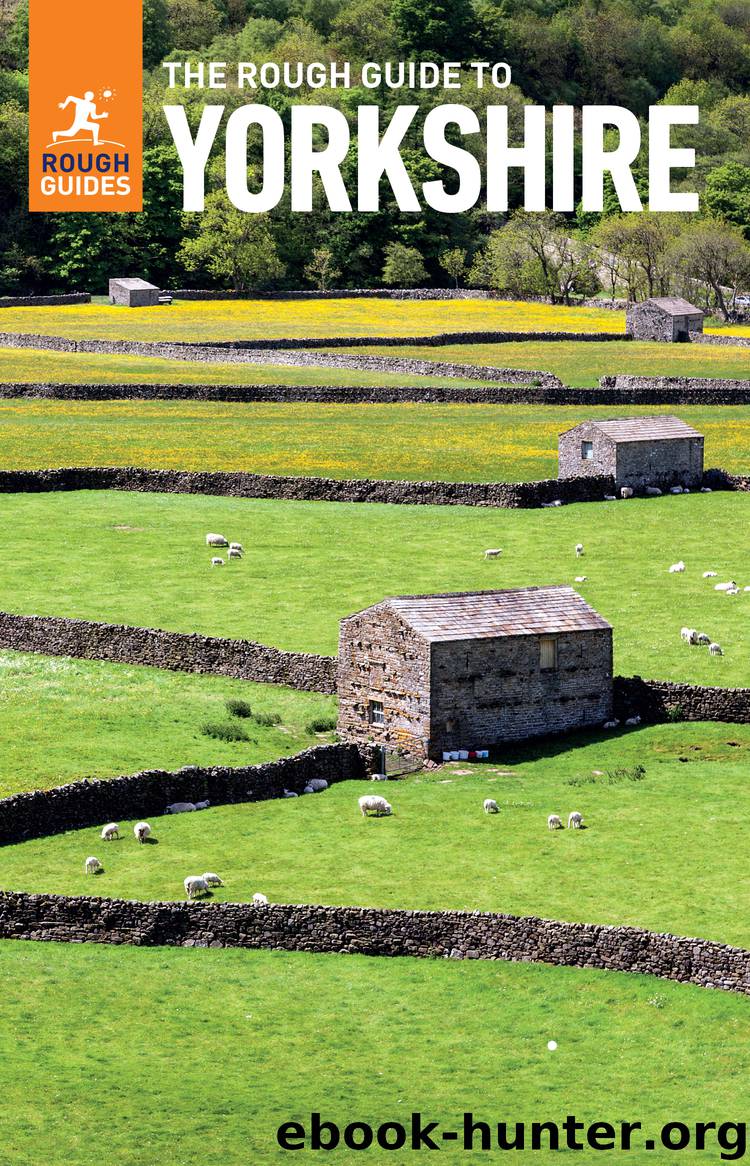The Rough Guide to Yorkshire (Travel Guide eBook) by Rough Guides

Author:Rough Guides
Language: eng
Format: epub
Tags: Travel, Great Britain
Publisher: Apa Publications
Published: 2019-03-02T10:10:15+00:00
Knaresborough Mill
If you walk down the steps from the castle and look downriver, you will see a double weir swinging the River Nidd around a curve. The eighteenth-century Knaresborough Mill, which the weir was built to serve, has at different times pumped water from the river up into the town, worked as a paper mill and been involved in a variety of cloth-making processes – cotton and flax spinning, and, right up to its closure in 1972, weaving flax. The buildings are now residential.
River Nidd
As you walk upriver from Knaresborough Mill along attractive Waterside, you will pass several cafés, one of which – The Marigold Café – rents out boats (March–Oct daily 10am–4pm; boats £6/person/hr; 01423 869773, marigoldcafe.co.uk) To the right of the café are the remains of the Old Dye House, built in 1610, where dye was made to supply the local textile factories up to 1840.
Fifty yards or so beyond, after a pleasant riverside terrace, the road passes under the railway viaduct. Built by Thomas Grainger of the East and West Yorkshire Junction Railway, it was finally completed in 1851, after an earlier attempt had collapsed. Made up of four arches at a maximum height of nearly 80ft, it is either an eyesore or a fine piece of civil engineering, depending on who you talk to. The view of Knaresborough from the castle would certainly be the poorer if it wasn’t there.
Old Manor House and around
Just upriver from the viaduct stands the black-and-white-painted Old Manor House, built as a hunting lodge for King John, and believed to be where Oliver Cromwell received the formal surrender of the Royalist forces defeated at Marston Moor, the biggest and most pivotal battle of the English Civil War, held around eight miles west of York on July 2, 1644. You’ll see a number of buildings in town decorated in this black-and-white chequerboard style. Continuing along Waterside brings you to the High Bridge, which is medieval in origin though was extensively repaired in 1773.
Mother Shipton’s Cave
Prophecy Lodge, High Bridge • March–Oct Mon–Fri 10am–4.30pm, Sat & Sun 10am–5.30pm • £7; family £22; parking £2 • 01423 864600, mothershipton.co.uk
Set in parkland that stretches along the riverbank from the High Bridge down to the Low Bridge, Mother Shipton’s Cave claims to be England’s oldest purpose-built tourist attraction. The site, which includes an adventure playground, a woodland adventure trail, refreshments and picnic areas, offers views of the viaduct, the weir and the town on the opposite bank, together with walks laid out by Sir Henry Slingsby in 1739. The cave itself is said to be where soothsayer Ursula Sontheil (aka Mother Shipton, her married name) was born in 1488. The story of Mother Shipton’s ability to predict the future is doubtless hokum, but since her death in 1561 the legend of her uncanny prophecies has grown, carefully tended no doubt by the people for whom it has provided, over the years, a decent living.
Petrifying Well
The park also features a so-called Petrifying Well – a spring that deposits minerals on anything immersed in it, petrifying them immediately.
Download
This site does not store any files on its server. We only index and link to content provided by other sites. Please contact the content providers to delete copyright contents if any and email us, we'll remove relevant links or contents immediately.
On Writing A Memoir of the Craft by Stephen King(4863)
The Doodle Revolution by Sunni Brown(4685)
A Simplified Life by Emily Ley(4099)
Mummy Knew by Lisa James(3632)
Marijuana Grower's Handbook by Ed Rosenthal(3622)
Better Homes and Gardens New Cookbook by Better Homes & Gardens(3525)
Figure Drawing for Artists by Steve Huston(3381)
Paper Parties by Erin Hung(3371)
Draw Your Day by Samantha Dion Baker(3290)
The Genius of Japanese Carpentry by Azby Brown(3224)
Japanese Design by Patricia J. Graham(3109)
The Code Book by Simon Singh(3074)
Dangerous Girls by Haas Abigail(2978)
Lions and Lace by Meagan Mckinney(2924)
The Curated Closet by Anuschka Rees(2913)
How to Make Your Own Soap by Sally Hornsey(2827)
The Checklist Manifesto by Atul Gawande(2779)
The Wardrobe Wakeup by Lois Joy Johnson(2733)
Zero to Make by David Lang(2726)
